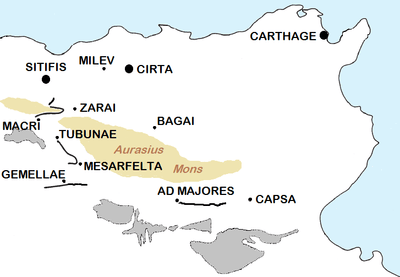Tubunae
Tubunae (or Thubunae) was a Roman-Berber city in Algeria. It is believed to have been in either ancient Mauretania Caesariensis and/or Numidia.

Characteristics
There were two towns called Tubunae in the territory of what is now Algeria, when it was part of the Roman Empire. One is referred to as Tubunae in Mauretania, because it was part of the Roman province of Mauretania Caesariensis. The other (the modern town of Tobna) is called Tubunae in Numidia, because it was situated in the Roman province of Numidia. Writers such as Morcelli uses the spelling "Tubunae" for both of them,[1] but the Catholic Church's list of titular sees refers to the second of them (corresponding to modern Tobna) as Thubunae in Numidia.[2]
There it is even the possibility that both names are for the same settlement.
Tubunae in Mauretania
The names of none of the bishops of this town, which is mentioned by Ptolemy, have been preserved. The see was vacant when Huneric summoned the North African bishops to Carthage in 484.[1]
Tubunae/Thubunae in Numidia
It was to this town "in the depths of Numidia"[3] that Augustine of Hippo and Alypius went, probably in 421, to meet the Roman official Boniface and exhort him "to serve the Church by protecting the empire from the barbarians".[4]
In 479 Huneric exiled a large number of Catholics there. Its ruins, known as Tobna, are in the Department of Constantine, Algeria, at the gates of the Sahara, west of the Chott el Hodna, the "Salinae Tubunenses" of the Romans. They are very extensive, for three successive towns occupied different sites, under the Romans, the Byzantines, and the Arabs. Besides the remains of the fortress, the most remarkable monument is a church now used as a mosque.[5]
Bishops
Three bishops of Tubunae/Thubunae in Numidia are known. Saint Nemesianus assisted at the Council of Carthage (256). Saint Cyprian often speaks of him in his letters, and we have a letter which he wrote to Cyprian in his own name and in the name of those who were condemned with him to the mines. An inscription testifies to his cult at Tixter in 360, and the Roman Martyrology mentions him on 10 September. Another bishop was Cresconius, who usurped the see after quitting that of Bulla Regia, and who assisted at the Council of Carthage (411), where his rival was the Donatist Protasius. A third, Reparatus, was exiled by Huneric in 484.[1][5]
See also
References
- Stefano Antonio Morcelli, Africa christiana, Volume I, Brescia 1816, pp. 331–332
- Annuario Pontifico 2013 (Libreria Editrice Vaticana, 2013, ISBN 978-88-209-9070-1), p. 998
- Peter Robert Lamont Brown, Augustine of Hippo: A Biography (University of California Press 1969 ISBN 978-0-52001411-4), p. 422
- William A. Sumruld, Augustine and the Arians (Association University Presse 1984 ISBN 978-0-94563646-5), p. 86
- Sophrone Pétridès, "Tubunae" in Catholic Encyclopedia (New York 1912)
Bibliography
- Laffi, Umberto. Colonie e municipi nello Stato romano Ed. di Storia e Letteratura. Roma, 2007 ISBN 8884983509
- Mommsen, Theodore. The Provinces of the Roman Empire Section: Roman Africa. (Leipzig 1865; London 1866; London: Macmillan 1909; reprint New York 1996) Barnes & Noble. New York, 1996
- Smyth Vereker, Charles. Scenes in the Sunny South: Including the Atlas Mountains and the Oases of the Sahara in Algeria. Volume 2. Publisher Longmans, Green, and Company. University of Wisconsin. Madison,1871 (Roman Tubunae)
![]()
%2C_Algeria_04966r.jpg)